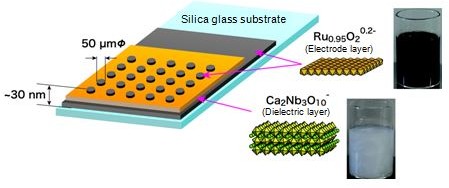Development of High-performance Dielectric Devices by Assembling Nano Blocks
Self-organization of oxide nanosheets through the solution process
2014.02.19
(2014.04.01 Update)
National Institute for Materials Science (NIMS)
A group of researchers led by Dr. Takayoshi Sasaki and Dr. Minoru Osada of the International Center for Materials Nanoarchitectonics (MANA) of NIMS, succeeded in developing the world's smallest high-performance capacitor by assembling two types of oxide nanosheets, - a conductive oxide nanosheet and a dielectric oxide nanosheet – into a sandwich structure, in the manner of LEGO block game.
Abstract
- A group of researchers led by Dr. Takayoshi Sasaki (Fellow) and Dr. Minoru Osada (Associate Principal Investigator) of MANA (Director: Masakazu Aono) of NIMS (President: Sukekatsu Ushioda), succeeded in developing the world's smallest high-performance capacitor by assembling two types of oxide nanosheets, - a conductive oxide nanosheet and a dielectric oxide nanosheet – into a sandwich structure, in the manner of LEGO block game.
- A capacitor is an electronic component used in various electronic appliances, such as smartphones and personal computers. The type of capacitor currently in common use is a multilayer ceramic capacitor (MLCC) formed by laminating alternating layers of dielectric material composed of ceramic nanoparticles and metal electrode. This type of capacitor has been reduced in size and improved in performance through what is generally called a “top-down” approach, by such means as creating thinner or integrated elements through the use of the advanced particle processing technology or thin film technology. Amid the recent trend toward making ever smaller, lighter and more sophisticated mobile devices, there is a call for further MLCC size reduction and sophistication. However, the existing technology has already reached its limits both in terms of materials and processes, and a dramatic increase in performance and technological innovation by means of new materials and processes is strongly demanded.
- By applying a “bottom up” rather than “top down” approach, in contrast to the conventional development of capacitor elements, the research group developed a new process with inorganic nanosheets - two dimensional nanocrystals with molecular thickness - for use in a novel element production. They thereby succeeded in creating the world's smallest high-performance capacitor element. More specifically, the researchers successfully fabricated films of nanoscale thickness to build a high-quality MIM (metal-insulator-metal) element by sandwiching alternating perovskite niobium oxide nanosheet (Ca2Nb3O10-) dielectric layers and ruthenium oxide nanosheet (Ru0.95O20.2-) electrode layers using a room temperature solution process. This element is the smallest in the world with a total thickness of less than 30 nm, and displayed stable, high capacitance (27.5 μF cm-2) over a broad range of frequencies between 103 and 106 Hz. The element prototyped in this research is equivalent to one unit of the MIM structure of an MLCC, and making it into a multilayered structure will be the future challenge. The new element performs about 2000 times better than MLCC elements currently on the market, and its use in forming multilayered element is practical because it can be fabricated totally through a simple, low-cost and environmentally friendly room-temperature solution process. The results of this research clearly lead to the development of practical applications in the future.
- This research was carried out as part of the research project "Development of Nanomaterials / Manufacturing Processes for Next-generation Electronics Using Inorganic Nanosheets" (Project Leader: Takayoshi Sasaki) in the "Establishment of Innovative Manufacturing Technology Based on Nanotechnology" Research Area of the Core Research of Evolutional Science & Technology (CREST) Program of the Japan Science and Technology Agency (JST). The research results was published in an online version of the journal, ACS Nano, at 22:00 JST, February 19, 2014 , and will concurrently be published in a press release by the American Chemical Society as a paper of the editor's choice.

Figure 1 A schematic of the dielectric nano-device newly developed using two-dimensional Ca2Nb3O10- and Ru0.95O20.2-nanosheets as materials for the dielectric layers and electrode layers, respectively. These nanosheets can be obtained in the form of a mono-dispersed colloid suspension as shown in the photos.